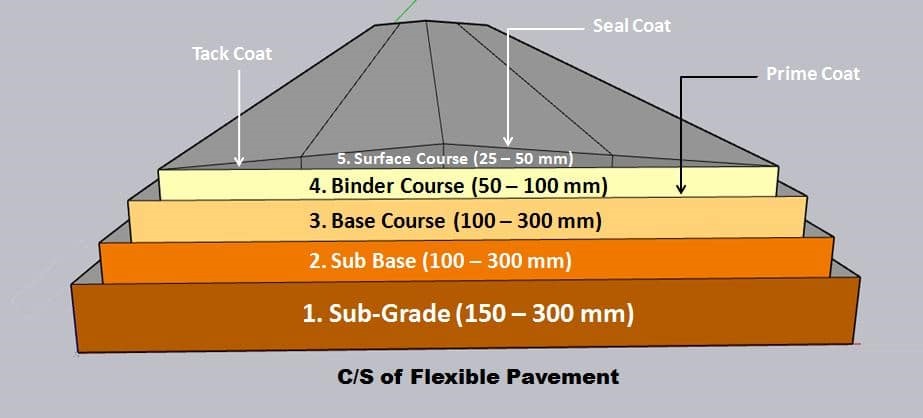Natural subgrade, compacted subgrade, sub base course, base course, binder course, and surface course are typical layers of a standard flexible pavement.

Subgrade:
- The top soil, also known as the subgrade, is a natural soil layer that has been prepared to withstand loads from the layers above.
- It’s crucial that soil subgrade is never overstressed. The ideal moisture content should be present, and it should be compacted to the desired density.
- Red gravel soil or moorum makes up its composition.
A good subgrade should have these qualities.
- Sufficient compressive strength to bear the imposed wheel load.
- Effective pore space is limited, which limits the amount of water that can enter.
- having the ability to endure abrasive and impact stresses from traffic and weathering
Sub base course:
- The sub base course is the layer of material below the base course, and its main purposes are to maintain the pavement structure structurally, enhance drainage, and lessen the incursion of fines from the subgrade.
- The sub base course with additional fines can act as a filler between the sub grade and the base course if the base course is open graded.
- The usage of a sub base course is not always necessary. For instance, the extra qualities provided by a sub base course may not be necessary for a pavement built over a high-quality, firm subgrade. In certain circumstances, sub base course might not be offered.
- Broken stones and bound or unbound aggregates make up this layer.
Base course:
- The layer of material immediately above the sub base is known as the base course, and it helps to subsurface drainage and additional load distribution.
- It serves as a medium for dispersing stresses to distribute the surface wheel loads.
- Crushed stone, crushed slag and other untreated or stabilised materials could be included.
Binder course:
The binder course typically consists of aggregates having less asphalt and doesn’t require quality as high as the surface course, so replacing a part of the surface course by the binder course results in a more economical design. This layer provides the bulk of the asphalt concrete structure. Its main function is to distribute load to the base course.
Surface course:
- It is the layer directly in contact with the traffic loads and is usually constructed with superior quality materials. They are usually constructed with dense graded bituminous concrete.
- The functions and requirements of this layer are,
- It provides characteristics such as friction, smoothness, drainage, etc., and it will also prevent the entrance of excessive quantities of surface water into the underlying pavement layers.
- It must be impervious, firm, strong and skid proof to provide resistance to abrasion, compression, tension, repetitive action of wheel loads and weathering action.
- It must provide smooth riding surface.
- It should offer water tight layer against surface infiltration.
Seal coat:
It is a thin surface treatment used to water proof the surface and to provide skid resistance.
Tack coat:
A very thin layer of asphalt emulsion diluted with water is used as a “tack coat” to promote bonding between two layers of binder course. It must be extremely thin, evenly cover the entire area, and dry quickly.
Prime coat:
In order to bond two layers together, a binder layer is placed on an absorbent surface, such as granular bases, and low viscosity cutback bitumen is applied to it. Prime coat, in contrast to tack coat, penetrates into the layer beneath, fills in the gaps, and creates a watertight surface.
